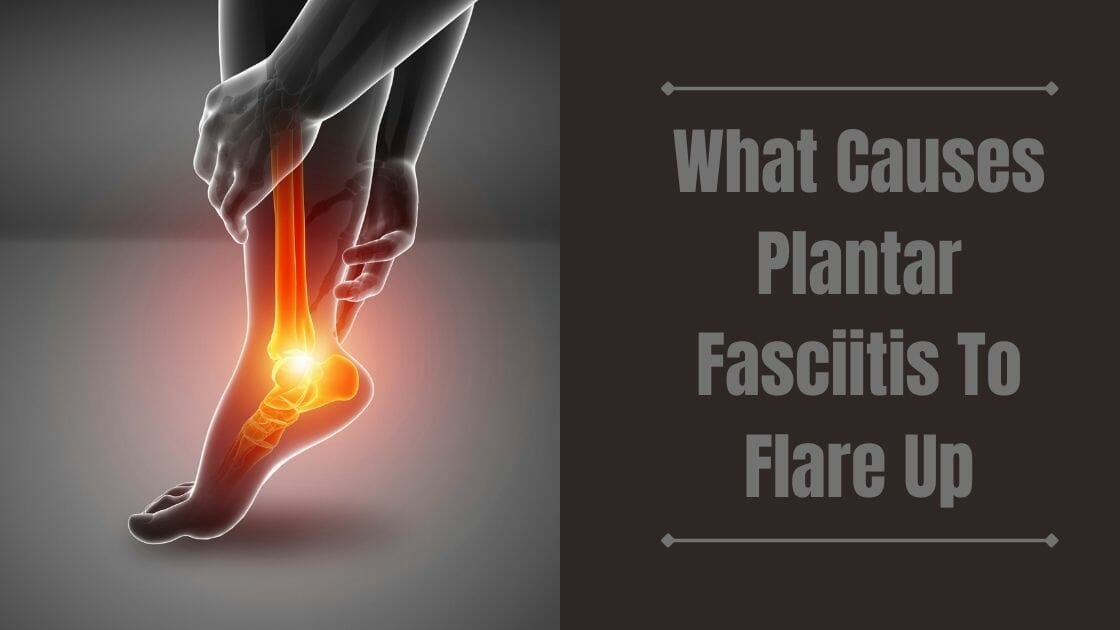When the force through your feet is too high for the plantar fascia to cope with, it can begin to tear. This causes the pain and swelling that people experience with plantar fasciitis.
The plantar fascia is a thick gang of tissue that runs from your heel to your toes and connects the heel bone to the toes. It helps to support the arch of your foot and acts as a shock absorber. When the plantar fascia tears, it can become painful and inflamed.
Table of Contents
What Causes Plantar Fasciitis To Flare Up
Plantar fasciitis is a chronic injury that develops when the force that goes via your foot is too high for the plantar fascia to cope with. This overload can occur gradually over several days or during one event that loads your feet more than they are used to.
Movements that can increase the force through your feet and aggravate plantar fasciitis include:
- Sitting for long periods
- Running
- Walking
- Excessive use of high heels
Sitting for long periods of time
Sitting for long generations is a big problem because it will cause the force through your feet to increase, which increases the risk of developing plantar fasciitis. This will cause you to sit in the same position all day and night. It is important to ensure that your shoes fit correctly and comfortably. If they are uncomfortable, you will not be able to get a good night’s sleep.
Running and walking are two other activities that increase the force through your feet. The force goes through your foot when you run and when you walk.
Running
The force goes through your foot and the heel bone when you run. The plantar fascia has to stretch to absorb this force. It is like placing a rubber band around your heel. When the force through your foot is too high, the plantar fascia can tear.
Walking
Walking is an excellent activity that can help you improve your health and fitness. Walking can be done in various ways, including brisk walking, jogging, and running. It is a great activity that can help you to improve your fitness. It can also help you to improve your cardiovascular system.
Weight Gain
Sitting for long periods is the most common cause of plantar fasciitis, as it increases the force through your feet and puts more stress on the plantar fascia. Running, walking, standing, and high heels are also common causes of plantar fasciitis.
Excessive Use Of High Heels
High heels can cause plantar fasciitis because they increase the force through your feet. They can also cause the arch of your foot to collapse. This will cause your feet to land with too much force on your heels and the plantar fascia.
Symptoms of Plantar Fasciitis
The most common symptom of plantar fasciitis is pain that starts in the bottom of your heel and spreads to your toes. It can also cause swelling and tenderness in the area of the heel. It can also cause the arch of your foot to collapse.
The pain can be felt when you are standing, walking, or sitting. It can also be felt when you are sleeping.
FAQs
How do you stop a plantar fasciitis flare up?
To help prevent a plantar fasciitis flare-up, try staying active and keeping your feet moving. Biking, walking, and swimming are all great exercises to keep your feet moving and help prevent inflammation.
Avoid standing or walking on hard surfaces.
What is the fastest way to cure plantar fasciitis?
There are several ways of curing plantar fasciitis. The most popular is probably a foot orthotic. However, some other less common options may be more effective for you. Surgical procedures can sometimes treat this condition, but only if the pain is severe and non-responsive to conservative treatments.
Will plantar fasciitis ever go away?
Plantar fasciitis is a situation that causes inflammation in the fascia, which is the connective tissue that runs along the base of your foot. The pain can be severe and debilitating, but it doesn’t have to be. It’s essential to get treatment right away, though, because plantar fasciitis can lead to heel spurs, and heel spurs can cause long-term issues.
Conclusion
In conclusion, plantar fasciitis is an unfortunate condition that can cause inflammation in the fascia, the connective tissue that drives along the bottom of your foot. It is a condition that can be treated, but only if treated right away.




















